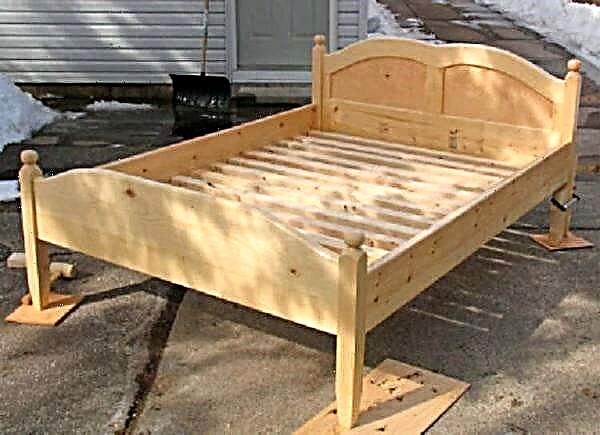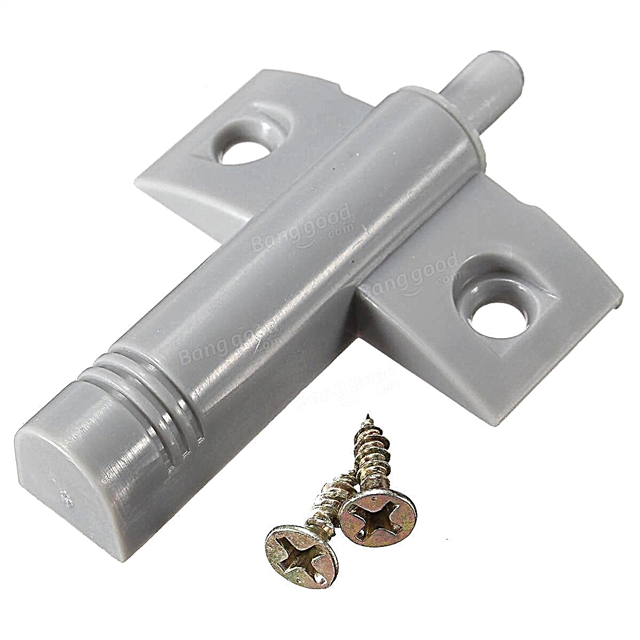
Acquiring a lawn with delivery is a great alternative to long and painstaking cultivation.
But an expensive purchase will take root in a new place only if it is correctly laid. This article will tell you how to lay a lawn roll.
Calculation of the number of rolls
The number of rolls required to cover the plot is determined as follows:

- calculate the area of the site by multiplying its width and length: S = A * B,
- divide the area of the plot S by the area of one roll. The most common format of a rolled lawn is 2x0.4 m, respectively, the roll area is 0.8 m. In this case, to cover a plot of 100 square meters. m will need 100 / 0.8 = 125 rolls.
There are rolls with an area of 0.6 square meters. m (dimensions 2x0.3 m).
With this format, to cover a plot of 100 squares, you need 100 / 0.6 = 167 rolls. On the websites of manufacturers, it is often proposed to multiply the area of the site by a certain coefficient. The essence is the same, just a factor of 1 / 0.8 or 1 / 0.6 is replaced by this very coefficient. In the first case, it will be 1.25, in the second - 1.67. Multiplying 100 sq. m on these coefficients, we get the same 125 and 167 rolls.
To the resulting number add stock:
- in the absence of landscape objects on the site: 5%,
- if there are paths, flower beds or fountains: 10% (more waste).
Thus, for a lawn area of 100 square meters. m with complex landscaping (margin of 10%), with a roll area of 0.8 square meters. m 100 * 1.25 * 1.1 = 137.5 rolls will be required (if necessary, add a margin of 5% instead of the coefficient 1.1, 1.05 should be used).
Having calculated the required number of rolls, make an order, while adhering to these rules:

- purchase and delivery are planned so that the lawn is laid within 24 hours. That is, the site should be prepared in advance. When postponing laying work for more than a day, you cannot leave the lawn in rolls: it is rolled out and watered,
- the later the coating is laid, the worse the grass takes root,
- it’s important to lay down the entire area in one go - then the coverage will be even and the same over the entire area
- for unloading rolls they take a place in the shade,
- in hot, dry weather, the sprays are sprayed with water.
The best time for planting a lawn is spring or autumn, when the sun does not bake and the soil is rich in moisture.
It is useful for a potential buyer to know the signs of a quality roll lawn (one roll is rolled to check):
- layers of turf and grass have equal thickness along the entire perimeter,
- no weed grass
- grass grows in a uniform layer without bald spots,
- the roots are tightly intertwined. Significant gaps between them indicate low quality.
When you try to pull the cloth on yourself, the grass does not lag behind the main layer. Otherwise, the plants will not take root well.
Territory preparation
For laying a rolled lawn, the site is prepared in the following order:

- remove debris and foreign objects,
- uproot old tree roots, stumps,
- weeds are removed in one of two ways: by hand weeding or continuous treatment with a herbicide - for example, Roundup. The herbicide acts for 2-3 weeks, applied to the green mass. If the decision is made to get rid of weed grass manually, it is recommended to dig the site, removing the roots. Of these, the most tenacious plants, such as wheat grass and dandelion, will sprout through the lawn and then it will be difficult to remove them. Along the way, the site gets rid of the larvae of insect pests,
- if necessary, equip drainage. It is required if there are puddles of water in the area after a rainfall or during a snowmelt. This happens on clay soils located in the lowlands,
- if there is no need for the arrangement of drainage, the soil is loosened to a depth of 5-10 cm. In small areas this is done with a manual aerator or pitchfork, in large areas with a walk-behind tractor.
Drainage is done like this:
- cut off the top layer of soil with a thickness of 40 cm and stack aside (in the future it will be needed),
- First, a 10 cm thick layer of gravel is poured into the excavation and tamped, then a sand layer of the same thickness (sand can be replaced with geotextiles),
- on top of a gravel-sand cushion, previously removed fertile soil is poured to ground level.
Create a horizontal surface
In preparation, the plot is leveled. A convenient guideline is several stretches of becheva stretched between the pegs. The distance from them to the ground shows where it is necessary to add soil and where to cut it.

Leveling the garden roller
If no drainage is established on the site, the surface is planned with a slope of 6 0 in order to divert rain and melt water.
Soil rolling
The next step is soil compaction. Without this, it will sag over time (there are always cavities in the upper layer) and irregularities will appear on the lawn. Consolidation is done with a garden skating rink (it is filled with water), and if it is not there - with a log or a wide board.
Normally, compacted soil should not sink under the feet of an adult. The site should be planned and rolled so that in the end its surface is 2-2.5 cm below the track (the thickness of the turf in a roll).
 The site is watered and fertilized:
The site is watered and fertilized:
- spring or summer: nitrogenous fertilizers,
- in autumn: phosphorus-potash.
Complex fertilizers for lawns are available for sale, which include, in addition to the main elements mentioned, a number of additional ones that contribute to the speedy survival and full development of grass.
Having spread the fertilizers, walk along the site with a rake to distribute them evenly and mix lightly with the ground.
Unfolding turf
The lawn is laid in this order:
- along the perimeter of the site in order to indicate its boundaries stretch the rope
- in the corner from the side of the unloading platform, roll out the first roll and correct it, giving the correct position. The rolled lawn is strong enough - you can safely drag it by hand,
- the second is rolled along the long side of the first roll so that their edges touch. The overlap (overlapping one edge on the other) is not allowed, as well as a significant gap - not more than 1.5 cm,
- half of the second roll is cut with a garden knife or a bayonet shovel. This is done so that the seams in the rows do not match. This approach is reminiscent of laying bricks with a run of seams,
- apply the third and fourth to the narrow sides of the first and second rolls, roll them out and straighten them.
Rolls are rolled only in a straight line. When you try to bend them on the lawn, folds and tears will appear, and then bald spots (due to poor survival of grass in these places). If the coating captures, for example, the corner of the flowerbed, it is rolled out and then cut off the excess.
Similarly, they lay the entire area with a lawn, ensuring the expansion of the seams by cutting in even rows of the first rolls by half. The cut fragment fits at the end of the row.
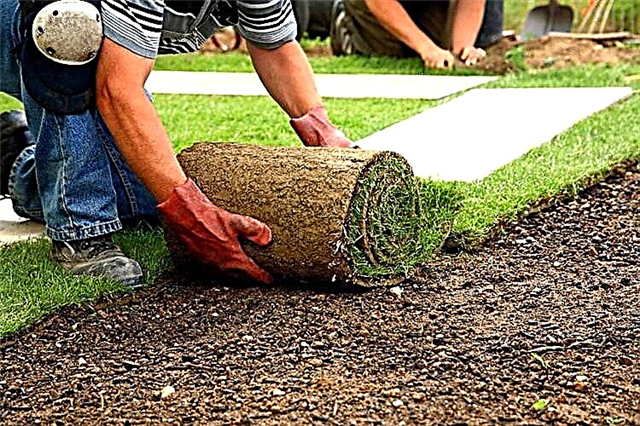
Laying a roll lawn
Worst of all, grass takes root with the edge of the plot, therefore it is important to lay fragments of at least 1 m in length. Smaller scraps are left for the middle part.
Ramming
Having finished the next row, they press down the lawn with a roller or a wide board, this gives a double effect:

- tight fit of the turf to the base is provided,
- the panels are spliced at the seams.
If the coating is dry, it is moistened before rolling. Along the way, he stroked his palm in order to identify hollows and tubercles. If they are found, they lift the cloth and level the base, adding or removing soil.
Then the lawn is crushed again. If for laying the next row you need to stand on a freshly laid coating, lay a wide board or wooden flooring. Otherwise, the turf is for sale.
Watering
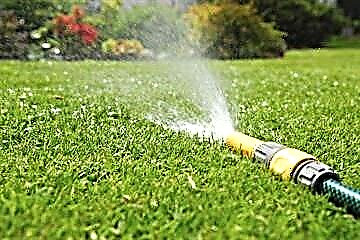 After laying, the lawn is poured with water. Water is not allowed to be sprayed - only with a sprinkler or nozzle.
After laying, the lawn is poured with water. Water is not allowed to be sprayed - only with a sprinkler or nozzle.
The irrigation intensity should be such that the soil base under the panels is saturated with moisture to a depth of 2-3 cm. This is checked by raising the edge of the lawn at 10-12 points around the perimeter.
The lawn is watered in the low position of the sun - in the morning or in the evening. Water droplets focus the sun's rays like a lens, therefore, during daytime watering, the grass suffers from burns. During the first 7-14 days (depending on the weather), the lawn is watered daily at the rate of 10-15 l / m 2.
Is the watering sufficient? Check according to the following criterion: the soil base under the turf should be moist to a depth of 5 cm. To check this, it is allowed to raise the edge of the coating in several places during the first week.
Lawn care
The user is advised to adhere to the following instructions:
- in the first 30 days after laying it is forbidden to walk on the lawn. If necessary, do this, put a boardwalk under the legs, and after use, immediately remove it,
- optimal frequency of watering - once every 5 days. In the heat - more often, in rainy weather watering is completely canceled,
- cut the grass after reaching a growth of 4-6 cm, but not earlier than the 8th day after laying. Most often for the first time this has to be done in 2–4 weeks.
During the first haircut, the mower is moved across the rolled rolls. In late autumn, shortly before the onset of cold weather, the lawn is trimmed to a height of 5 cm. Such grass overwinter well under snow. It is advisable to remove cut grass so that it does not block the access of air, sun and water to the ground.
Remove cut grass in three ways:

- use a lawn mower with a grass catcher,
- remove garbage manually with a rake,
- the lawn is periodically treated with a special tool - a scarifier: it cuts with the knives the accumulated "felt" from the cut grass and collects it in a bag.
In addition to watering and haircuts, the following activities are carried out:
- fertilizer application
- mulching: leave cut grass in small quantities as fertilizer and in order to prevent soil loss of moisture,
- aeration
- weed removal.
Related videos
Step-by-step instructions on how to lay a rolled lawn:
Buying a finished lawn simplifies the life of the owner of the site and saves a fair amount of his time: it takes 2-3 years to grow the same “from scratch”, that is, from seeds.
With proper care, the emerald lawn will delight households for decades. The main thing is to observe the laying technology and to properly care for the plants, following the recommendations given in this article.
Manufacturing technology of rolled lawn
 The lawn is cut with flaps of 0.8 square meters. It consists of a turf and an upper grass layer. Sod is the topsoil. The thickness of the roll lawn is 2 cm, length 2 m, and width 40 cm. Each roll weighs from 15 to 30 kg, depending on soil moisture.
The lawn is cut with flaps of 0.8 square meters. It consists of a turf and an upper grass layer. Sod is the topsoil. The thickness of the roll lawn is 2 cm, length 2 m, and width 40 cm. Each roll weighs from 15 to 30 kg, depending on soil moisture.
It is noteworthy that the lawn in rolls is used to solve many problems in landscape design. Artificial hills or small slopes can be decorated with such grass. The Gorgazon company knows everything about the technology of laying a lawn roll. You will find a full range of services and prices in the relevant sections of our website - Prices for a rolled lawn and A device for a rolled lawn.
Lawn laying technology - preparing the ground for a lawn
Before laying the rolls, the ground must be prepared. It is treated with specialized preparations for weeds. Shoveling is carried out mechanically. Stumps, shrubs and trees that interfere with future landscaping are also removed. After these procedures, the earth is dug up; if necessary, new plant soil is added. Sometimes special. equipment. This is necessary in order to get rid of old roots, other debris underground. Sometimes it is necessary to level (leveling the level). After that, the entire territory is treated with a rake for leveling and obtaining the most even surface.
In accordance with the technology of laying the lawn in rolls, the ground for laying the lawn should not have swellings, bulges or strong elevations. The soil should be moderately compacted and smooth. The technology for laying a roll of lawn involves mixing the soil with special fertilizer, which helps the root system of grass rolls adapt faster. You can also get the necessary dressings from us.
The process of laying a lawn
Having bought rolled grass, do not delay with its deployment. This coating does not tolerate long storage. Starting to lay the lawn cover, the grass mats are neatly unfurled and laid on the cleared land. The technology of laying the lawn in rolls involves laying out the flaps in a checkerboard pattern. Each edge of the strip should be in close contact with the other edge. The technology of laying the lawn implies that after the flooring everything is carefully tamped to ensure maximum contact of the root system with the soil. All roll laying activities are carried out extremely carefully so as not to damage the turf. To make the sod better grow to the ground, experts use a light garden skating rink. Garden paths and car areas should be slightly above the soil layer. This is necessary to achieve the same level after installation.
No. 1. Types of Roll Lawn
Rolled lawn makes it possible in the shortest time, organize the perfect grass cover almost anywhere, which is its main advantage. He found application in various fields, so today it is customary to single out such main types of rolled lawn:
- ground floor. It is distinguished by the highest decorative qualities, it has a uniform color, velvety surface, very dense. The main disadvantage is sensitivity to excess moisture, lack of sun and other factors. This is a very capricious coating, which is used to decorate the local area. Walking on such a lawn is strictly prohibited - he will not bear such an impact. In the country, it can only be used to decorate flower beds, but specific care will also be required,

- sports lawn It is intended for the arrangement of football fields, sports fields and other territories with a high load. Coverage consists mainly of herbs such as ryegrass and bluegrass. This mixture is very resistant to trampling and other negative factors, but this does not mean that you do not need to take care of such a lawn. You can use it to organize a playground in the country,
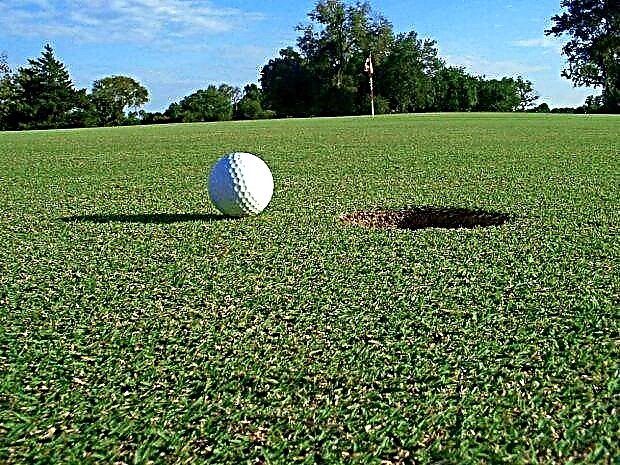
- universal lawn received the most popularity. It is precisely him who is used in cottages, because he is well resistant to various weather factors and can withstand an active load, so you can run around without problems. You can use the lawn almost everywhere, and in the country it will become both a decoration of the site and a picnic area.
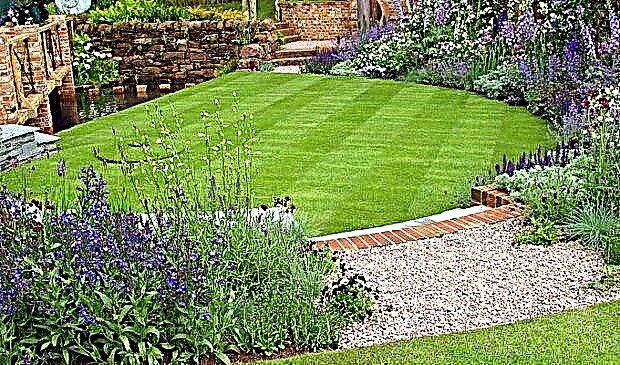
No. 2. Advantages and disadvantages of a rolled lawn
What makes a rolled lawn so popular among summer residents? The answer to this question lies in the listing main advantages of coating:
- minimum time to organize a lawn. If the estimated area of the lawn is small, then the coating can be created in one day,
- uniformity, density, the intensity of the color of the rolled lawn, because it is grown on special farms using a mass of equipment that is not available in a regular summer resident. At home, it’s much more difficult to grow such a high-quality coating,
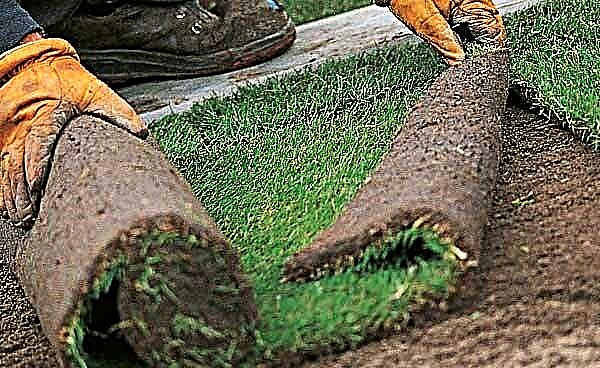
- relative ease of care. The rolled lawn gets to your site already 3 years old, i.e. he managed to accumulate enough strength to better resist the negative environmental factors. Experienced summer residents say that in such a coating for the first time even weeds do not grow,
- watering a rolled lawn can be done less frequently than sowing, and with fertilizers things are much simpler,
- a rolled lawn requires only 8-10 cm of fertile soil. For a sowing lawn, this figure is a minimum of 20 cm.
You can also talk about the unpretentiousness of a rolled lawn, about the possibility of using it on uneven surfaces and in shady places, wherever a regular lawn has sprouted. The only negative is the high price, but many rightly believe that it pays off with a guaranteed result, elegant coverage, minimal time investment and easy maintenance.
Number 3. How to grow a rolled lawn?
In short, then a rolled lawn is an ordinary sowing season, only a company specializing in this sows it for you, takes care of it for three years, wateres, fertilizes and cuts it, and then cuts it into small fragments together with turf. They are sold to the buyer, who then spreads the finished lawn in his country house: the roots of the grass grow in the ground, and a full-fledged coating comes out. Here is such a simple transplant!
Now information for those who crave details. Rolled grass is grown in a special large area nursery using special equipment. From the time of sowing to sale takes 1.5-3 years, it’s better to take a 3-year-old lawn, because it already has a well-formed root system, and the grass cover itself is quite dense.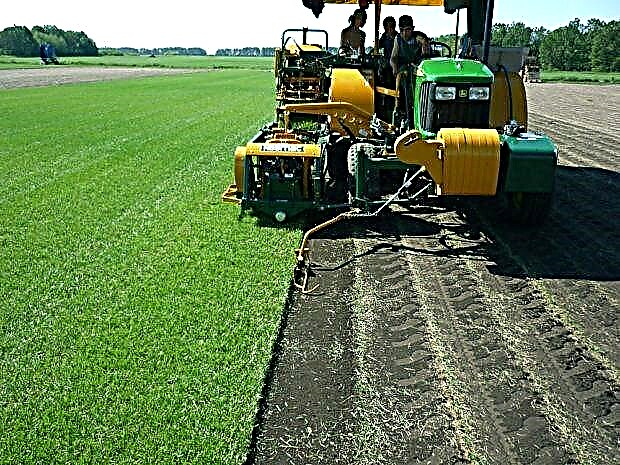
Depending on growing technology roll lawn can be of two types:
- using mesh. In this case, a grid of agrofibre is laid out over the entire area of the future coating, and only then does the seed sow. As a result, the roots of the grass reliably intertwine with the net, forming a durable lawn that is easy to transport without any consequences,
- without mesh. In this case, no additional devices are used, and the strength of the roll is ultimately provided only by the roots of the plants and their plexus. In principle, the turf is reliable enough to cut off the cover and transport it. In terms of cultivation and transportation, such a lawn is still more demanding, but fans of all natural prefer this coating.
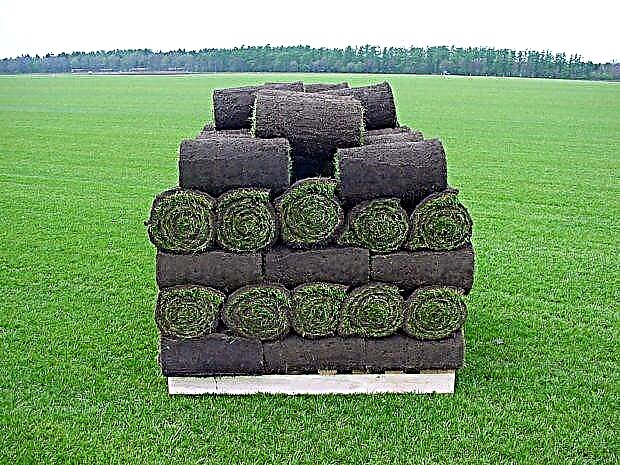
Except for this moment, then the technology for growing a rolled lawn on all farms is the same:
- preparation of the soil in order to loosen it and break the lumps. To do this, use a cultivator or a plow, then large particles of the earth are broken with a harrow,
- soil treatment with herbicides in order to destroy all weeds in the area where the lawn will be grown,
- if the lawn will grow on the grid, then it is laid out at this stage, given the size of the future coating and the features of the irrigation system,
- sowing with a prepared mixture of seeds,
- proper fertilizing and watering for several years,
- regular cutting, so that the cover becomes dense, and the roots are well intertwined,
- cutting the finished lawn, folding into a roll and transportation.
Cutting grass with the base occurs on the eve of transportation. Ideally, no more than a day should pass from cutting to laying, otherwise the roots of the grass will dry out, which will lead to the death of the lawn. If it is not possible to quickly transport and lay the coating, then it is placed in a refrigerator, where it can live no more than 4 days.
Number 4. Sizes of a rolled lawn
As a rule, grass is cut along with the base fragments 2 m long and 40 cm wide, but these parameters may vary slightly from one manufacturer to another. Width rarely exceeds 48 cm. With these dimensions, the lawn is easy to cut, roll, and transport. The thickness of the lawn should be 2-4 cm, meaning turf. The height of the blades of grass, as a rule, reaches 6-7 cm.
Lawns for special purposes may have completely different parameters. For example, a sports lawn is sold in rolls 1 m wide and up to 15 m long.
As for lawn weights, then the exact figure is difficult to name here - a lot depends on soil moisture. On average, 1 m 2 of the coating weighs 17-25 kg. It turns out that a truck with a carrying capacity of 20 tons will be able to transport about 700 m 2 or more of rolled material at a time.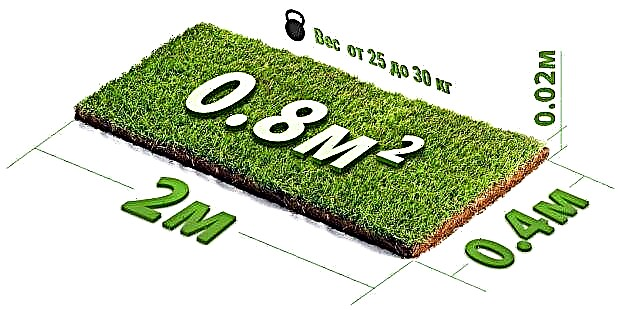
No. 5. What herbs are used?
No need to be an agronomist or a gardener with experience in order to understand that the main operational qualities of a lawn depend on what herbs are present in its composition. Manufacturers select a mixture so as to provide certain qualities to the coating, i.e. the composition of the grass will be different for each type of lawn. If we talk about the most popular universal lawn, the mixture often consists of such crops:
- bluegrass meadow Is a culture with emerald-colored grass. The lawn, which is 100% made of such grass, belongs to the premium segment, but requires careful care, especially in the first three years, but in the end it turns out a great finish. The universal coating is only part of this culture,
- red fescue differs in the increased resistance to trampling, does not dry, does not turn yellow, well tolerates a haircut. This is a persistent and unpretentious culture, the root system of which is developing quite intensively, due to which the slow growth of bluegrass is compensated
- perennial ryegrass gives a dense grass cover in the first year. Culture lives for only three years, so it gradually gives way to other herbs, but the purpose of its use in our business is precisely to provide a dense cover at a time when other cultures are only gaining strength.
The composition of the herbs may vary, but most manufacturers take fescue and bluegrass as the basis. If the mixture contains other herbs, do not forget to find information about them in order to understand what awaits you in the end.
No. 6. How to understand that you have a quality rolled lawn?
Each manufacturer almost swears that his lawn is of the highest quality and almost immortal. Is this really so, each of us can check in person, and to do this, you just need to be careful enough, and pay attention to the following aspects:
- cut quality. The thickness of the base over the entire area of the lawn should be the same, the roots should be reliably intertwined and form, as it were, an integral pillow. Necessarily the presence of young white roots,
- the soil without stones, not overly clayey and not sandy,
- weeds, bald spots and yellowed spots are not acceptable
- Blades of grass should be the same size, density - 100 or more shoots per 10 cm 2. To quickly evaluate this indicator, you can attach a cigarette pack to the lawn and count the number of shoots - there must be at least 50,
- lack of pests and diseases,
- it’s better to take a freshly cut lawn, as under long blades of grass small-leaved weeds may be hidden,
- experienced summer residents are advised to carefully take the grass cover near the edge and pull it, very slightly, without applying excessive effort. Grass should not be pulled out. If this happens, then it has weak roots and it will be impossible to get a good lawn.
Doesn't bother to look at the documentation, the presence of which indicates the integrity and seriousness of the seller, allows you to verify the regularity of lawn checks for quality. When familiarizing yourself with documents, pay special attention to the place where the grass was grown to make sure that your future lawn grew from an area with a favorable ecological situation.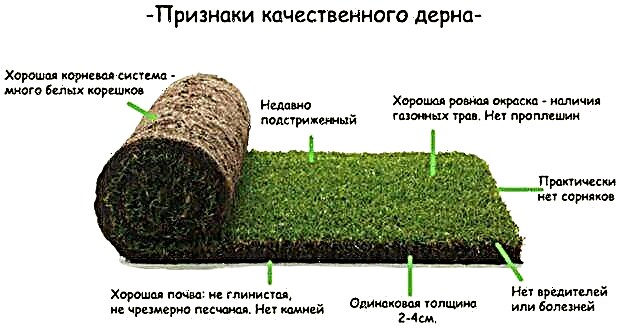
Number 7. How many rolls do you need to buy?
If you know the area of the territory that needs to be decorated with a lawn, and the area of each individual roll, then calculating how many rolls are needed is a task for a second-grade student. From the manufacturer you need to find out the area of one roll of the selected lawn, or take the length and width parameters, and then multiply them.
The next step is to determine the area of the plot given to the lawn. If this territory has the shape of a regular square or rectangle, then the task is simplified as much as possible. It is necessary to determine the area of this site and divide it by the area of one unit of lawn roll.
Example. We sell the lawn in rolls 2 m long and 40 cm wide. The area of one sample is 2 * 0.4 = 0.8 m 2. We need to lay a lawn on a site with parameters 6 * 5 m, i.e. area of 30 m 2. To cover this area, you need 30 / 0.8 = 37.5 rolls, rounded up to 38. In this case, 5% is provided for the stock. It turns out that we need to order 40 rolls.
If the shape of the plot is complexIf there are curved lines, bends and other details, it is better to draw a plan on paper and draw a lawn layout diagram. You will have to literally draw each of the rolls to visually see how many of them are needed. You can do it in another way. From the school geometry course, we remember how to look for the area of a complex figure. It is necessary to break it into simple figures and find the area of each of them. This is what they do, and then they act according to a familiar pattern, only in this case, 10% of the result is added to the stock, since if there are bends and tracks, the material consumption will be higher.
Number 8. When can I lay a lawn roll?
Manufacturers say roll lawn can be laid at any time of the year, starting from early spring and ending in late autumn. In principle, the way it is, but laying in the autumn period has a lot of features, and if possible, it is better to refuse such an undertaking.
The best time is springwhen the soil is no longer frozen and not oversaturated with excessive moisture. At this time of the year the grass grows actively, so in the summer you will receive a luxurious thick green lawn, as from the picture.
Fall laying the lawn is possible provided that in the region the autumn is usually warm, long and soft. The grass will grow and gain strength until the moment when the air temperature drops to +5 0 C. Until this point, the shoots of grass can already grow enough, so they will protect the roots of the grass from winter frosts. In spring, one difficulty may lie in wait for you: it will be difficult for young shoots to break through the layer of last year's grass, so in the end the lawn can turn out to be uneven.
Difficulties can arise when laying a lawn in summer. In general, it is better not to do this, since transplanting is already a big stress for the grass, and when the temperatures are high, the risk of drying the rolls is increased. If you can’t wait, you will have to water the lawn very often, up to twice a day, so that the sod grows well with the soil, since the roots still cannot get enough moisture from the soil.
No. 9. Soil preparation for laying a roll lawn
Now let's get to the fun part. When everything is counted and selected, all the pros and cons are weighed, the moment of laying the lawn roll comes. It all starts with proper soil preparation on the site. As you might have guessed, just throwing a lawn roll across the territory will not work - the probability that it will take root in this case is low. Given the fact that the brought lawn must be laid on the same day, then the preparation of the territory must begin in advance.
The sequence of actions is as follows:
- to clear and dig the site, remove the roots of perennial weeds. For warranty, you can treat with herbicides,
- make measurements using the level. If there are areas with a strong slope, it is better to sprinkle them with earth so that in the future water does not accumulate there,
- add an additional fertile soil layer 5 cm thick on top, you can add dolomite and peat to it. This stage can be replaced by the use of special fertilizers for lawns. They are scattered around the site, and then carefully raked into the ground,
- tamper with a homemade lawn roller or wide board. The goal is to finally level the surface and compact the loose soil to prevent subsidence. Checking the quality of the tamper is simple: you have to step on the ground, and if there are no traces on it, then everything is fine. If there is a trace, then you can again ramming,

- keep in mind that the roll lawn has its own thickness of 2-4 cm. As a result, the site should be flush with garden paths, so a fully prepared site should be 2-4 cm below the desired level,
- in lowland areas and high clay soils, it may be necessary to organize drainage, as the lawn does not like excessive moisture. Drainage is easy. 40 cm of soil is removed from the site, it is stored for later use. 10 cm of gravel and 10 cm of sand are poured into the bottom (instead of sand, you can use geotextiles), then the stored soil is poured at the level.

No. 10. How to lay a rolled lawn with your own hands?
To do all the work yourself is not difficult:
- follow the rule "laying on the day of delivery",
- You can start laying from the part of the site where you folded the rolls,
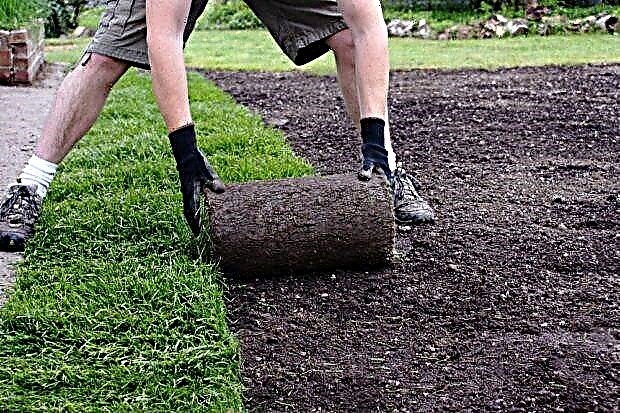
- put the first roll exactly in the corner of the platform, then carefully unwind it, trying to make it as even as possible,
- it is impossible to stretch, bend, twist the roll. If somewhere in the path of the lawn there is an obstacle, or the roll is longer than necessary, it is cut with a knife or spatula,
- the next roll is laid end-to-end to the previous one, without lapping the edges and leaving no gaps of more than 1.5 cm,
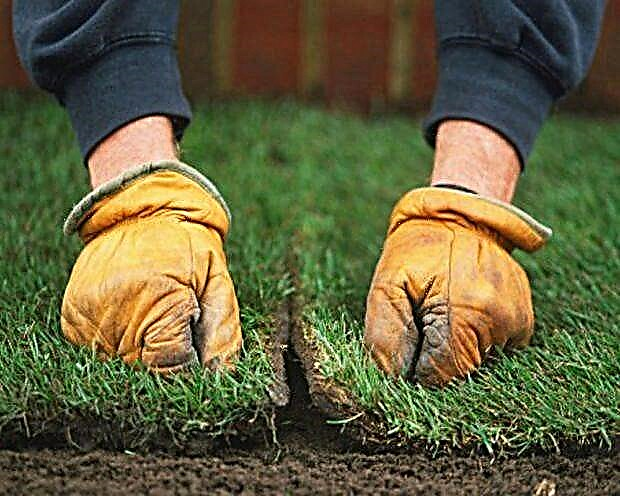
- when the first row is laid out, they start laying the second, but it is better to use chess stitching, i.e. Shift each new element half a roll relative to the previous one. To make it work, the laying of a new row begins with a roll that is shorter than the standard length. It’s like brickwork,
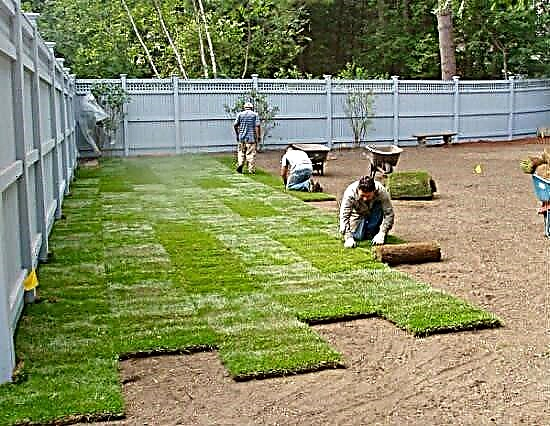
- edges are the weakest point in terms of survival, so it is not allowed to use small sections of rolls for their installation. Fragments of less than 1 m are best used in the center of the site, and the edges should be laid out with rolls of more than 1 m,
- when the first row is laid, it is gently rammed with a board to ensure full contact of the turf with the ground. Iron the coating with your hands to see if there are pits under the base. If there are any, then it’s better to raise the roll and add soil,
- to cover places of a complex-shaped area, a fragment of a suitable shape is cut from the turf,
- if for laying new rows it is necessary to go through the newly laid lawn, then it is better to lay a dense board on it so as not to stomp on the fresh coating,
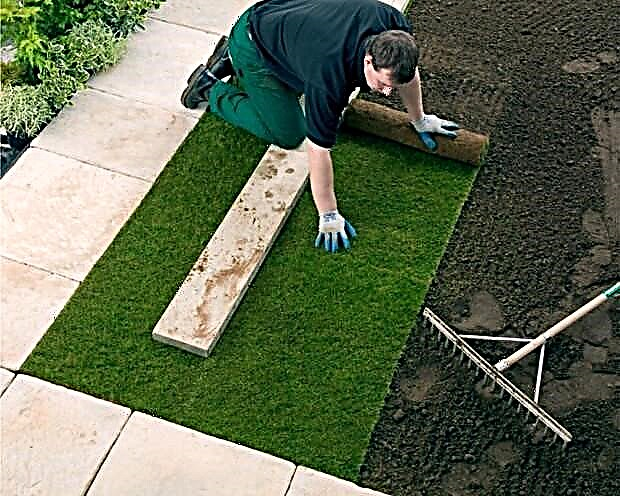
- seams are best covered with fertile soil. For clay soils, it is recommended to take peat, loam and sand in a ratio of 1: 2: 4, for sandy soils - in a ratio of 2: 4: 1, for peat soils use a mixture of peat and sand in a ratio of 3: 1.
What to do if the lawn is delivered, but it is impossible to lay it on the same day, or it turns out, but not all? To try to extend the life of the grass, unwind the rolls, moisten them and protect them from the sun, and be sure to start laying the next day.
No. 11. Lawn care after laying
The main secret of good survival of a roll coating is high-quality hydration. When the laying work is completed, water the lawn abundantly at the rate of 1 bucket of water for every 1 m 2 of surface. If you slightly raise one of the rolls over the edge, you can see wet sod and moistened soil in the area. In this case, watering is done correctly.
In the next 2 weeks, the lawn should be watered every day, trying to prevent the soil from drying out. Ideally, automatic sprinkler irrigation. It is better not to walk on the lawn during the first month, and you can use boards to move around, which should be removed immediately after the transition is over. During this period, there is a fusion of turf with soil.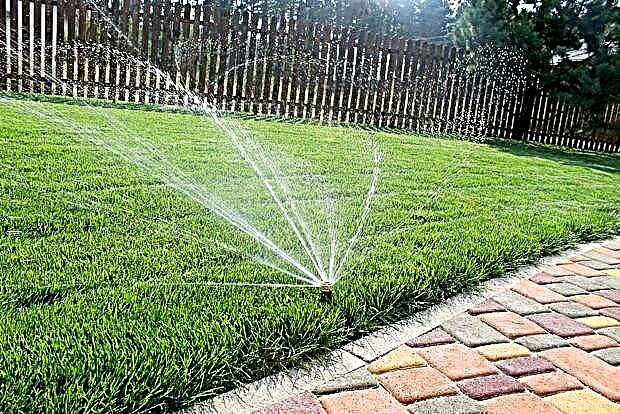
Further care looks like this:
- 4 weeks after styling, you can carry out the first haircut, but cut off only the tops, leaving the length of the blades of grass at 6 cm.Later, you can choose any desired length, but it’s better to lower the knives in the lawn mower gradually,
- watch for weeds and pull them out right away. In the future, this problem will become less relevant, since the root system of lawn grasses will strengthen, become dense and will not miss weeds,
- watering is carried out as the soil dries. In the absence of precipitation, focus on the frequency of watering 1-2 times in 10-12 days,
- haircuts are carried out from April-May to October. In wet periods, the haircut is carried out more often, in the summer - less often, and the knives of the lawn mower at this time are placed higher than usual,
- Before wintering, it is necessary to cut so that the grass has managed to grow at least 4 cm. In this case, the root system will be reliably protected from snow,
- before winter, the lawn is cleaned of all debris and fallen leaves,
- from the second year after laying before irrigation, mineral fertilizing can be carried out.
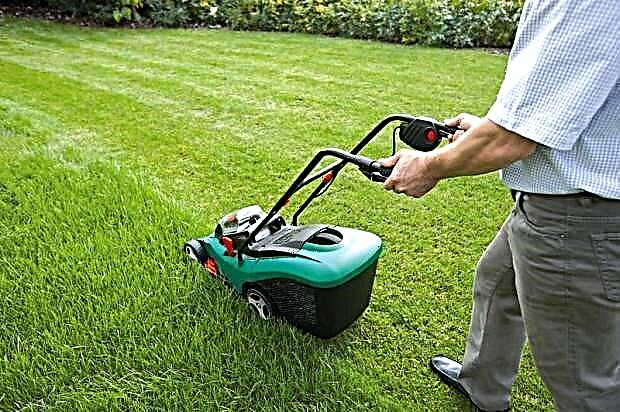
The green lawn will fit perfectly into any landscape design, goes well with flower beds, flower beds, shrubs and even beds. The easiest and fastest way to ennoble your own plot is to use a roll lawn. In a month you will be able to run on it, sunbathe and arrange cozy family picnics.
Features
The main feature of a rolled lawn is that it is a live grass that you can buy and lay on your site. Professionals are engaged in the cultivation of grass and the manufacture of rolls from it. Material is transported in rolls. The device of a rolled lawn on a site takes a little time.
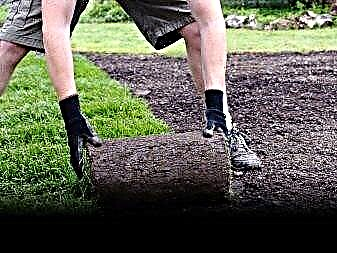

In the market of goods today you can find two types of rolled lawn: on the substrate and without it. The rolled lawn on the substrate has an artificial base between the layers of stems and roots. Most often, this is a grid of special fiber, which before planting the seeds covers the soil of the site. Germinating, the roots of the grass tightly intertwine with the base and form a durable canvas. The second type of lawn does not involve the use of any foundation.
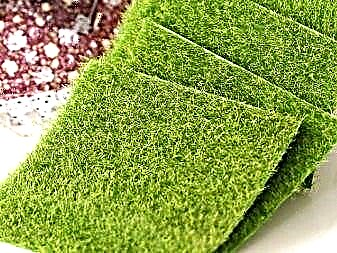

The root system of plants is so tightly intertwined that the grass cover is easy to cut and well tolerates transportation.
Grown in one way or another, the canvas is cut into strips, rolled up and transported to the landing site.
The standard lawn strip has dimensions of 2 by 0.4 meters, its area is 0.8 square meters. m Other slicing options are possible.


In order for the lawn to please its appearance for many years, it is necessary to initially choose high-quality material. When buying a bay with grass roll out and carefully consider. Experts do not recommend making a purchase if:
- weed plants grow along with ornamental herbs,
- places without grass are visible on the canvas,
- the lawn has an uneven thickness,
- the grass has a poorly developed root system,
- there are many gaps between the roots.




Everyone quality lawn roll has a certificate indicating the location of the nurserywhere he was grown and made. This information helps to get an idea of the ecological state of the grass in a roll.
The required number of rolls is calculated by the area of the land. They buy grass with a small margin, since various unforeseen situations are possible when laying. The rest of the grass is planted separately and, if necessary, used to repair the main canvas.


To calculate the number of rolls, do the following:
- Measure the length and width of the plot on which you plan to plant a lawn,
- The measurements are multiplied and get the area of the future lawn in square meters,
- With a rectangular section, another 5% is added to the resulting number. If the site is irregular in shape, add at least 10%,
- The area of the plot (increased by 5-10%) is divided by the area of one roll,
- The result of the division is rounded up. The resulting number will show how many rolls of lawn will be required for planting in this area.

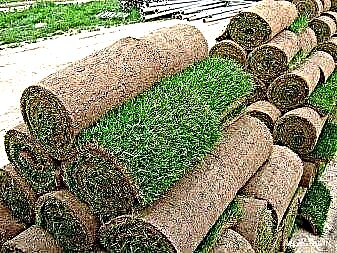
Site preparation
A plot for the lawn must be prepared a few days before planting. The preparation is as follows:
- Seat selection. For the device of the lawn, choose territories with a depth of groundwater of more than 50 centimeters. Lawn grasses like the sun, so for the lawn they choose the sunniest place in the yard.
- Cleaning the land from debris. Everything is removed from the plot area, including the remains of plants. If there are irregularities on the surface of the earth, then they are leveled, falling asleep holes and cutting off the hillocks. The site should have a clean and even surface.
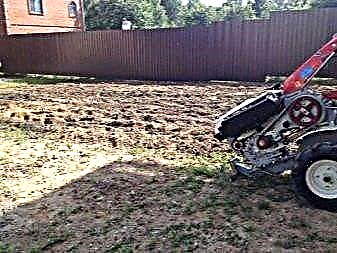
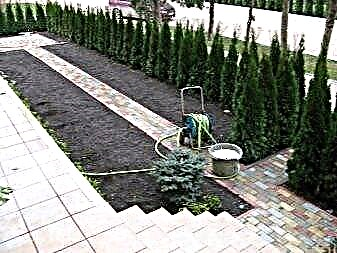
- Soil cultivation. The soil is cultivated or simply dug. In this case, weeds are destroyed. Remains of rhizomes are removed.
- Creating a drainage layer. If the soil is clayey and capable of retaining moisture for a long time, make a drainage layer. To do this, remove part of the soil and pour a layer of a mixture of sand and gravel. A layer of fertile soil is poured on top.
- Preparation of the fertile layer. It should have a thickness of at least 15 centimeters. If necessary, pour it. The surface is leveled. To make the future lawn look natural and fit well into the design of the site, the level of the prepared area is made a few centimeters below the surrounding area.


- Soil compaction. The prepared surface is tamped. Do this only in dry weather. To compact the soil using a heavy hand roller or improvised means. The soil is compacted so that there are no traces of shoes on it. Walking on a compacted area is not recommended.
- Fertilizer application. 7 days before laying, a complex of fertilizers is applied to the soil. If the lawn is laid in the spring, then nitrogen components are used. In the fall, potassium and phosphorus are added.
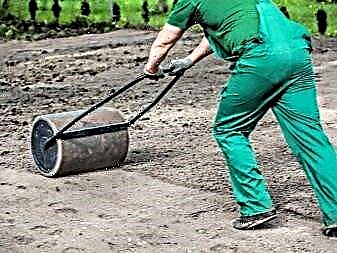

How to plant?
The technology for planting a rolled lawn is quite simple and can be done with your own hands. Laying the lawn is carried out in three stages.
Sequencing:
- Lay strips on the prepared surface,
- Roll out the lawn
- Pour over water.
When laying yourself, it is important to follow the basic rules:
- Laying the lawn begins from the curb or fence.
- The strips are positioned strictly butt, tightly pressing against each other. There should be no gaps between the layers, as well as overlays.
- The first row is laid out in whole strips of lawn, trying to put them as evenly as possible.
- The second row begins not with a whole strip, but with a half. To do this, the strip with a shovel or knife must be cut in half and lay one part of it. Next, whole strips are used, and the remaining part of the first strip is closed.
- The third row and all subsequent odd rows are stacked as the first row.
- The fourth and all subsequent even rows are laid as the second row. As a result, the stripes will be staggered, which subsequently allows you to hide the seams between them.
- Pieces of the lawn are laid closer to the center, while exclusively solid bands are used at the edges.
- If there are obstacles, such as the edge of a flower bed or a garden path, the roll continues to be rolled out in a straight line, and then with a sharp knife, grass is cut along the contour of the obstacle.
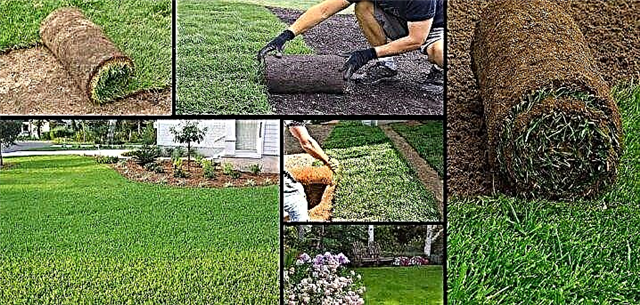
- Having laid the strip, check the tightness of the layer to the soil. This can be done by running your hand over the surface. If unevenness is found, the strip is raised and the cause eliminated.
- When the entire lawn is laid, it is rolled away. For rolling use a special garden skating rink. It is performed for a more snug fit of the grass root system to the ground and in order to remove the air cavities that are formed during laying. Repeat the procedure again on the third day after laying.
- A laid lawn immediately begins to be watered abundantly.
- During the first 3-4 weeks they do not walk on the lawn, since the grass during this period is prone to dents.

Care Tips
In order for the lawn to please those around you with its appearance, you need to properly care for the lawn. Especially carefully monitor the lawn in the first year after planting.
Grass care includes such types of work as:
- Watering,
- Top dressing
- Mowing,
- Rake combing
- Aeration
- Repairs.
Water is the main thing, without which not a single plant will survive, and a rolled lawn is no exception. In a hot summer for seven days, the lawn loses about 25 liters of life-giving moisture. Dry soil found at a depth of ten centimeters under the deck should be an alarm - soon the grassy coating will begin to lose elasticity, become dull and unattractive.
It is necessary to ensure constant soil moisture under the lawn at least 10-15 centimeters deep. Otherwise, the herbs that make up the lawn will eventually begin to dry, turn yellow and eventually die. Watering hoses must be equipped with spray tips. This will prevent erosion of fertile soil and will not damage the roots of plants.
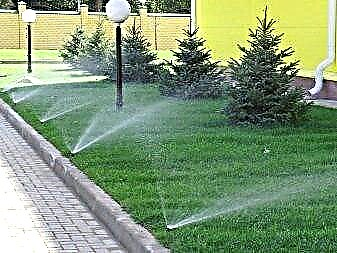
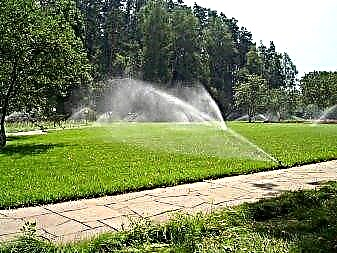
You should not water the lawn in the midday heat, because plants can die from a sharp temperature drop. Water temperature should not be lower than 14-15 degrees.
Watering a new lawn is carried out for the first two weeks daily, carefully making sure that the soil under the lawn does not dry out. Further irrigation frequency depends on weather conditions. In dry weather, you need to water every 2 days, in cool time, water at least 1 time in 10 days.
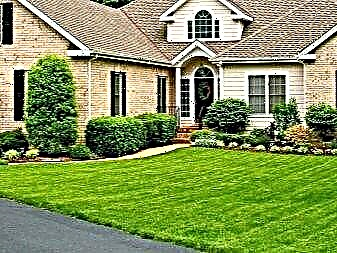

Fertilizing with fertilizers is a very important part of lawn care. It is carried out twice a year - in spring and autumn. Fertilizers are used the same as for ordinary plants: potassium, phosphorus, nitrogen, mixtures of trace elements.
Nitrogen accelerates the growth of grass mass, activates the formation of sprouts. Phosphorus has a positive effect on the root system, enhances its development. Potassium affects the rate of flow of water and nutrients to parts of the plant, especially to its root system, increases the resistance of roots to low temperatures.

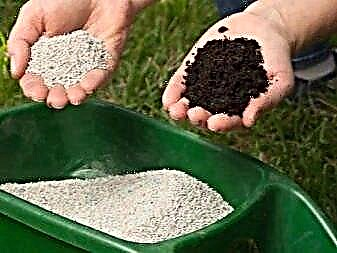
In the spring, fertilizers are added even before the snow cover disappears. Autumn top dressing is done to better prepare the root system of plants for wintering. In autumn, complexes of mineral fertilizers containing phosphorus and potassium are used.
In no case should fertilizers containing nitrogen be used in the fall. This is due to the fact that nitrogen compounds cause a rapid development of vegetation, and in autumn this is not necessary, since young grass quickly dies from frost.


Mowing or mowing grass is done in order to give the lawn a neat appearance. The first time the lawn is mowed about a month after laying. The trimmer of the lawn mower must be adjusted so that only the uppermost parts of the plants go under the cut, not more than 1-2 centimeters.
In the future, the lawn is sheared at a height of 6-7 centimeters, and in order to accelerate the growth of the cover and at 4 centimeters. The cut grass is removed.
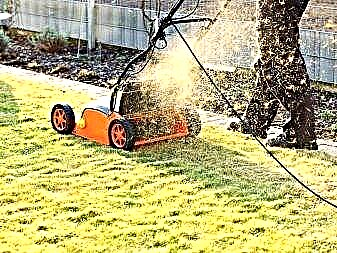
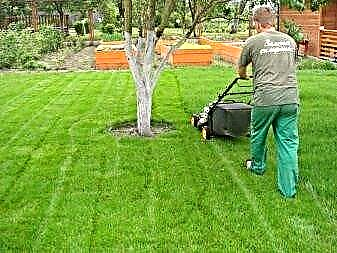
The first spring haircut is carried out in a gentle mode - as at the initial stage, only the tops of the plants are cut. The last autumn haircut is performed before the first frost. At the last haircut, make sure that the stems of the grass remain at least 5 centimeters high. This will allow the grass to winter well.
To remove garbage from the lawn, as well as mowed parts of plants, comb it with a garden rake. Lawn combing is performed in the spring and after each grass mowing. In the spring, the lawn is combed after all the snow has melted. At the same time, debris accumulated during the winter, the remains of old grass and excess moisture are removed from the surface. If additional drainage is necessary, the sods are slightly raised with the help of garden forks every 25-30 cm.


The lawn is treated several times with a rake in different directions: along, across, diagonally. At the same time, pressing the rake hard is not recommended, so as not to damage the root system of plants.
Regular brushing promotes improved grass growth, protection against the spread of weeds on the lawn whose seeds can be carried by wind or birds. After the first haircut, the grass is not combed, as it must be allowed to take root.
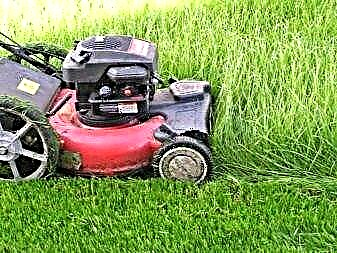

The dense root system of the lawn requires good airflow for good growth and development. For this systematically carry out aeration. Aeration is air saturation, in other words, airing.
This process has a very simple technology. Small holes are made on the surface of the lawn and the topsoil with special devices, often home-made. That is, the surface is simply pierced. As a result, the soil under the root system is enriched with oxygen, and the lawn becomes more healthy.


In the fall, aeration must be done when preparing the lawn for wintering. Autumn piercing of the infusion allows you to remove the water accumulated after the autumn rains and protect the root system from freezing.
Lawn repair is performed as necessary during spring cleaning and in autumn when preparing the lawn for wintering. First, the lawn is combed with a rake. If bald patches or areas with a thinned cover are found on it, then it is necessary to loosen the soil in these places, mix the seeds with the ground and sow the area. Be sure to seal the surface and pour plenty of water.
To repair the lawn, you can also use the parts of the lawn that were left during planting and planted elsewhere. Stripes of the required size are carefully cut and covered with non-overwintered areas.
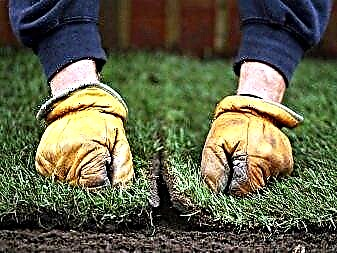

In order for the lawn covering to take root well and throughout the summer to please the owners with its well-groomed appearance, you should try to avoid the most common mistakes in leaving:
- Do not cut the grass at the beginning of the season. A young lawn needs to be mowed, because after mowing the grass becomes thicker and more resistant to weather conditions.
- Grass is cut too short. Stem height of 1-2 centimeters is detrimental to the roots! Plants will be deficient in nutrients and moisture. And some herbs do not tolerate such an aggressive haircut and die.
- Grass is cut too high. The optimal height of the grass after mowing is from 3 to 5 centimeters. At higher grass, the stems are exposed and the lawn loses its attractiveness and softness.

- The haircut mode is not respected. You need to mow the grass regularly, approximately every two weeks.
- Wrong watering. In order for the lawn to look good, it does not need to be watered abundantly daily. This will only hurt coverage. It is enough to moisten the coating several times a week using the sprinkling regime, and once a week to water the grass thoroughly, so that the soil under the lawn is saturated with water. Daily hydration is only useful in the first month after planting. For adult grass, this does more harm than good - the roots develop poorly, the grass quickly loses its leaves and dries.
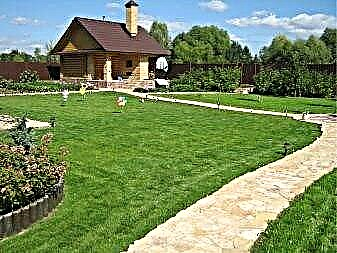
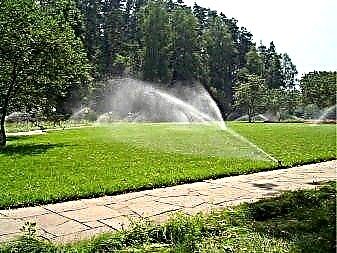
Spectacular examples
A modern lawn in the country house or in the courtyard of a country house can act not only as a separate functional recreation area, but also serve as a link for all areas of the site. The use of rolled lawns allows you to realize any landscape design ideas in a short time.
Often on the site, the lawn is combined with garden paths. If you additionally plant flowers between them, then the whole composition can become a real decoration of the yard.
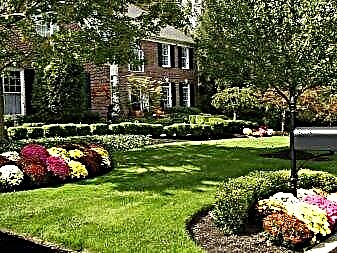

Leaving grass sections of different heights when mowing the lawn and skillfully combining them with each other, you can get wonderful compositions based on a combination of different geometric shapes, up to circles and spirals.
It looks interesting combination of grass and stone on the lawn. In this case, both natural and artificial stones are used.
The stone ornament can be laid out along the path or directly along the lawn, forming beautifully curved walking paths. The cobblestones used for this are recessed into the turf for fixation.
The combination of square lawn rolls and the same size of paving slabs laid in a checkerboard pattern looks beautiful and very stylish.
The lawn decorated with a figuratively trimmed decorative shrub looks spectacular. Ideally, an evergreen boxwood is used for this. Its small sheet cover keeps its shape well with a curly haircut, allowing you to get interesting decor elements - from simple ribbons to complex plot compositions. But boxwood shrubs are thermophilic and do not take root in the northern regions.
An excellent alternative to boxwood is the cotoneaster, which is in no way inferior to it in decorative properties.
Another way to decorate the lawn is to combine the lawn with decorative elements. To create a composition using stones, decorative fountains, garden sculptures.
For more information about the device and laying of the lawn roll, see the next video.














